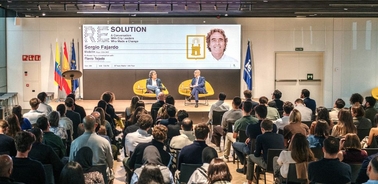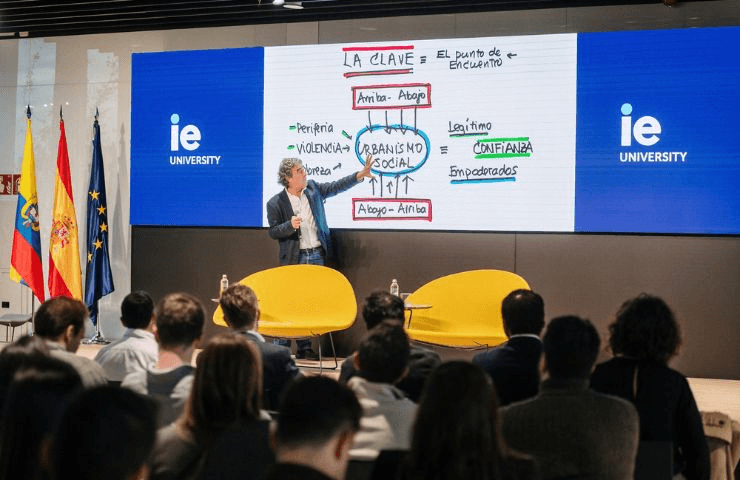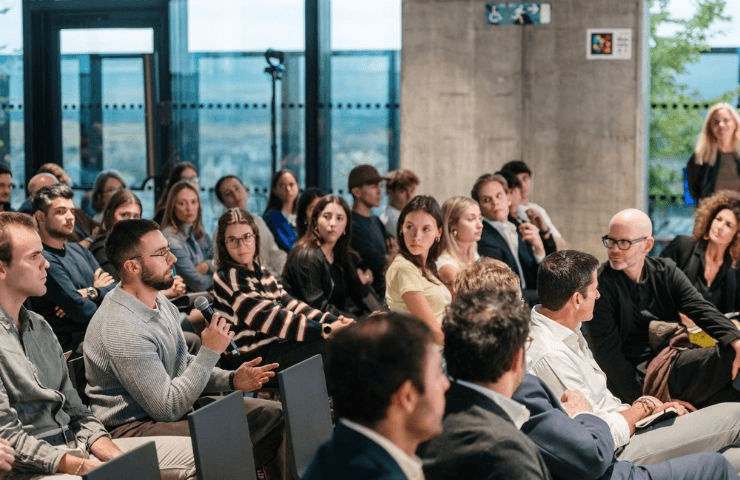Former Mayor Sergio Fajardo Shares Main Lessons From Rebuilding Medellín at IE University

Opening the IE School of Architecture and Design’s 2025–2026 RE_SOLUTION series, Fajardo highlighted how civic leadership, education, and design can drive urban and social change.
Madrid, 14 October 2025 – IE School of Architecture and Design inaugurated the 2025–2026 public lecture series, Re_Solution: A Conversation with City Leaders Who Made a Change, with a keynote address by Sergio Fajardo, former Mayor of Medellín (2004–2007), expert in public leadership, and presidential candidate in Colombia’s upcoming 2026 elections.
A mathematician by training, Fajardo has been internationally recognized for his innovative approach to governance and social transformation. He received the Golden Medal 2008 from the Federación Panamericana de Asociaciones de Arquitectos (The Pan-American Federation of Architects Associations) for his program of social urbanism, as well as the City to City Barcelona FAD Award 2009 and the Curry Stone Design Prize 2009 for his urban renewal model and transformative public works.
In his talk, "Medellín: From Fear to Hope," Fajardo revisited one of the most celebrated urban transformations of the past decades, illustrating how education, architecture, and trust played a key role in Medellin's renewal. Following the keynote, Sergio Fajardo shared his views with Flavio Tejada, Co-Director of the Masters in Real Estate Development at IE School of Architecture & Design.
Social Urbanism
Fajardo began his lecture by highlighting Medellin's challenges and potential in the late 1980s and 1990s. At a time when levels of violence were high and some neighborhoods were under the influence of narco-trafficking networks, the city was "deeply wounded," he said, "not only by bullets, but by the loss of trust among its people." He recalled how fear and inequality created a "fragmented city," divided socially and physically. "The culture of illegality destroyed the social fabric and made us believe that change was impossible," he explained.
In this context, the civic movement Compromiso Ciudadano, led by Fajardo, proposed building hope through education, transparency, and beauty. His political project, "Medellín, the Most Educated," committed to placing knowledge, dignity, and public trust at the center of politics. "Being the most educated was the furthest aspiration possible from being the most violent city," Fajardo said. "We wanted to make education the moral and civic foundation of our transformation."
At the heart of Fajardo’s administration lay the so-called "Social Urbanism"—a strategy that integrates physical space, social programs, and civic participation into a coherent framework. Under this vision, urban design was not merely about infrastructure, but about restoring dignity to communities long excluded from public investment. He described the approach with two guiding principles: "the most beautiful things for the humblest people" and "changing the skin of the city."
His administration implemented Integral Urban Projects (PUIs) that combined architecture, education, and public participation in the city’s most vulnerable areas. Among these were the now-iconic library-parks (parques bibliotecas), cultural and educational hubs designed as catalysts for community life, and the Metrocable, the first aerial cable system used for daily urban transport, connecting hillside neighborhoods to the city’s economic core. Each intervention, Fajardo explained, sought to "open opportunity doors through the wall of illegality."
He also shared the philosophy behind the city’s school program: building schools as the most beautiful places in each neighborhood, symbols of respect and belonging. "Architecture can be an act of affection," he said. "When a child walks into a place built with care and beauty, they understand they matter."
Beyond buildings, Fajardo emphasized that Medellín’s transformation depended on rebuilding trust between citizens and institutions. His administration pursued radical transparency so that "everything we do can be seen." Fajardo recalled that he and his team "walked every single street corner in Medellín," learning directly from residents and demonstrating that government presence could mean listening, not policing.
Connecting design, ethics, and leadership
Bridging the lecture and discussion, Flavio Tejada highlighted how Fajardo’s experience aligns with IE School of Architecture & Design’s mission to connect design, leadership, and ethics. "What Dr. Fajardo has shown us is that architecture and urban planning are not just about physical transformation—they are about rebuilding the social contract," Tejada said. "Cities change when design and politics work hand in hand with trust."
Together, both experts reflected on how design professionals and policymakers can collaborate to address the challenges of the 21st century, from inequality and migration to climate adaptation, without losing sight of human dignity and civic purpose.
At the event, IE University students asked about the challenges of governing with integrity, financing large-scale social projects, and sustaining civic engagement over time. Fajardo encouraged them to approach leadership as an ethical and collective endeavor. "Transformation is not the work of one person,” he said. “It’s the work of citizens who believe in their city and refuse to give up."

